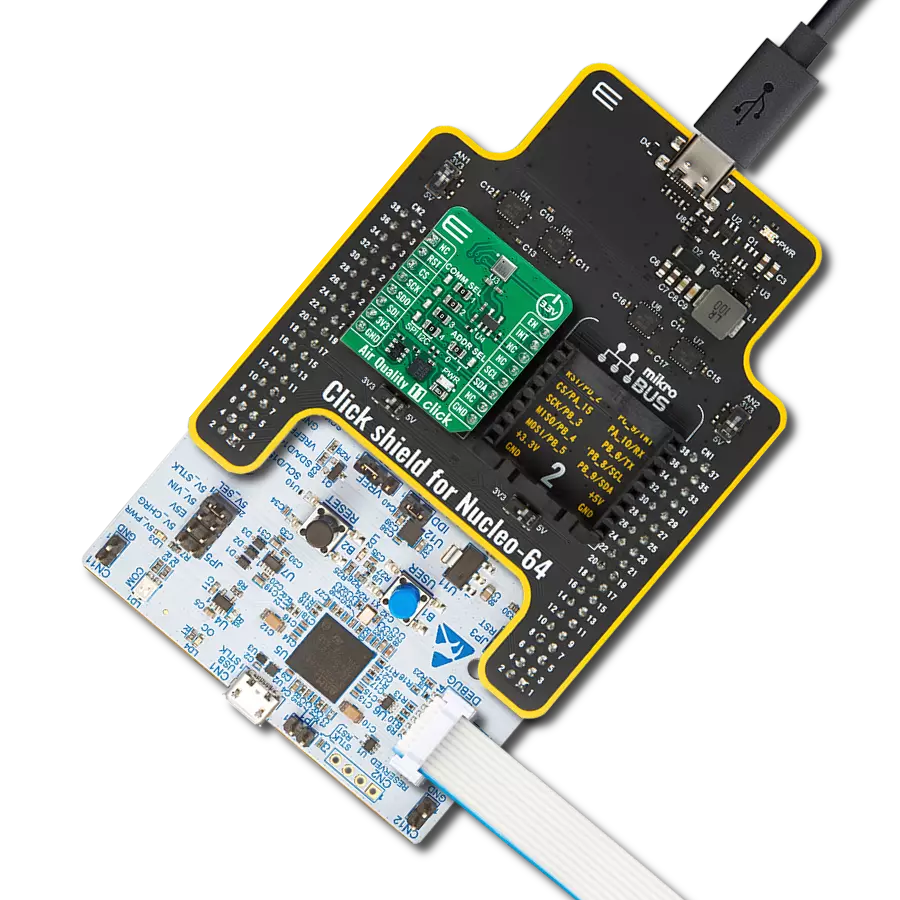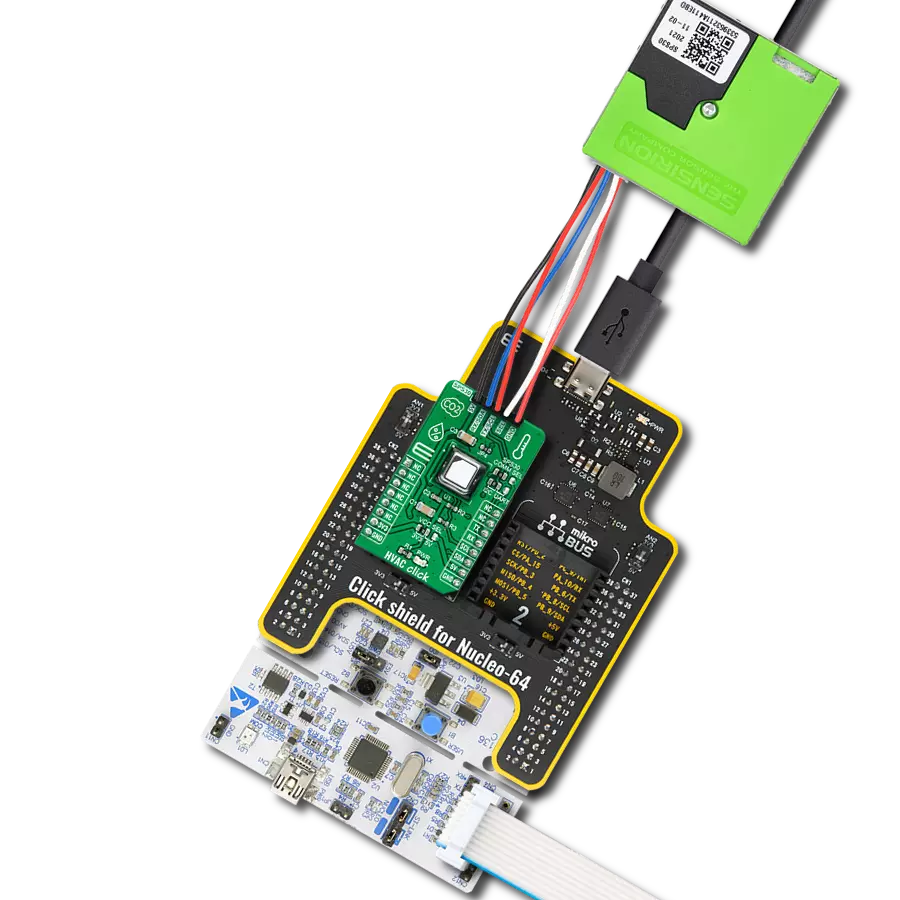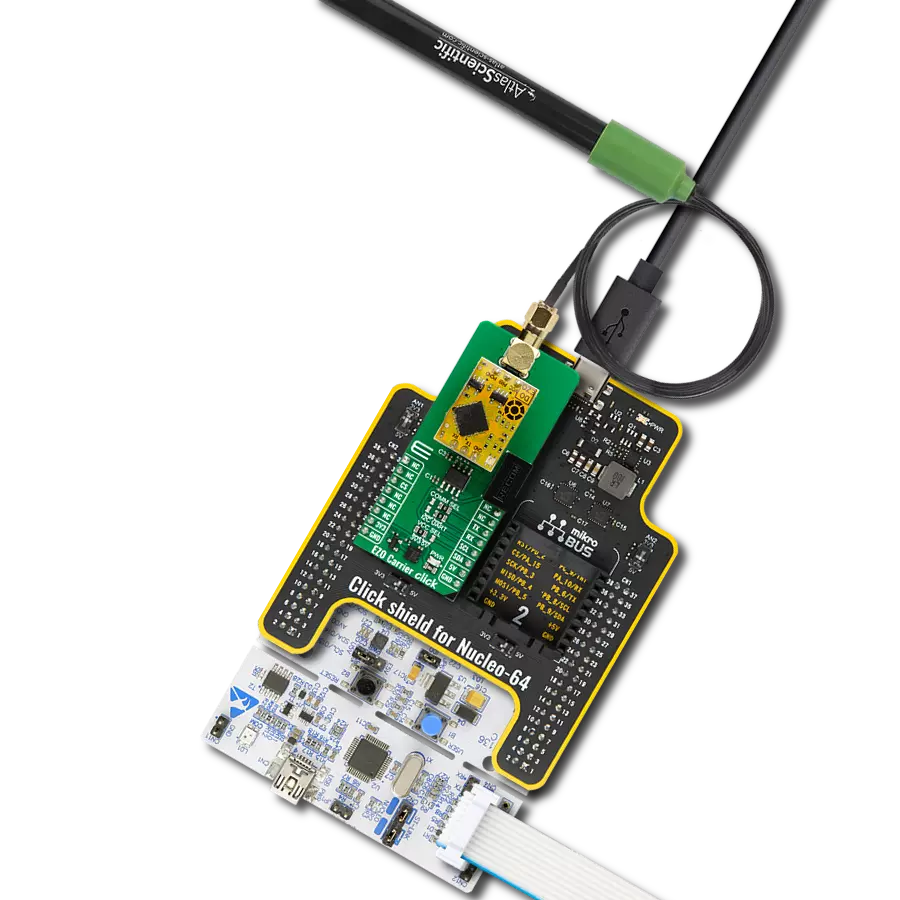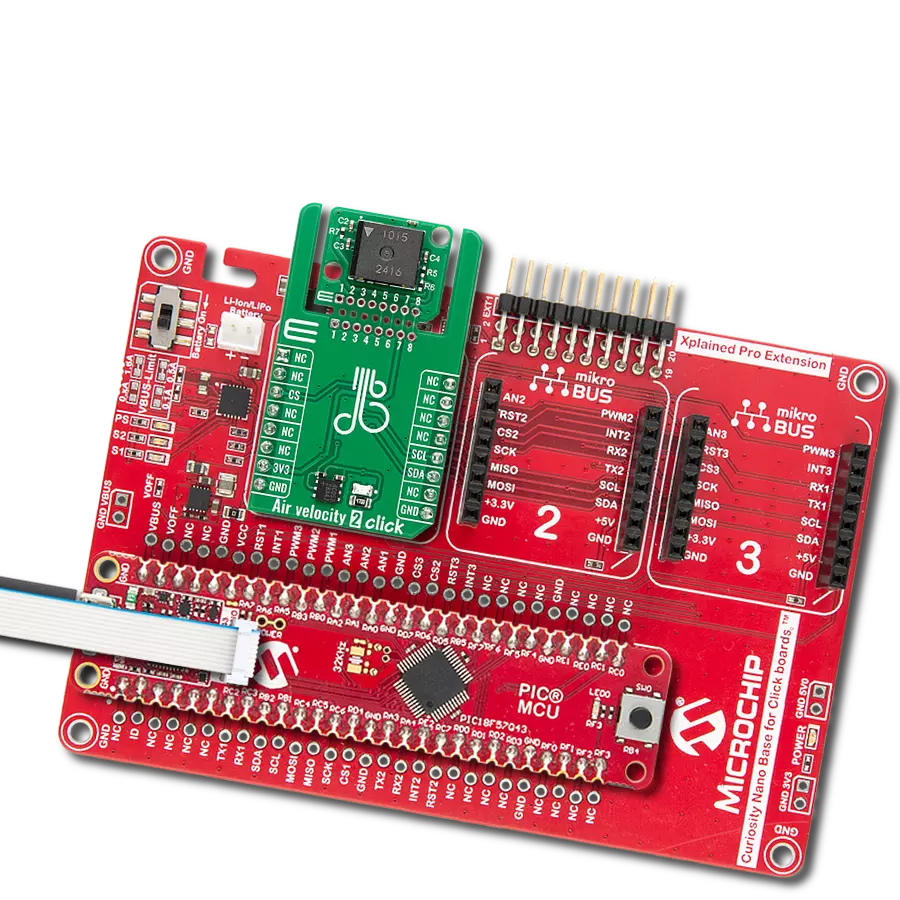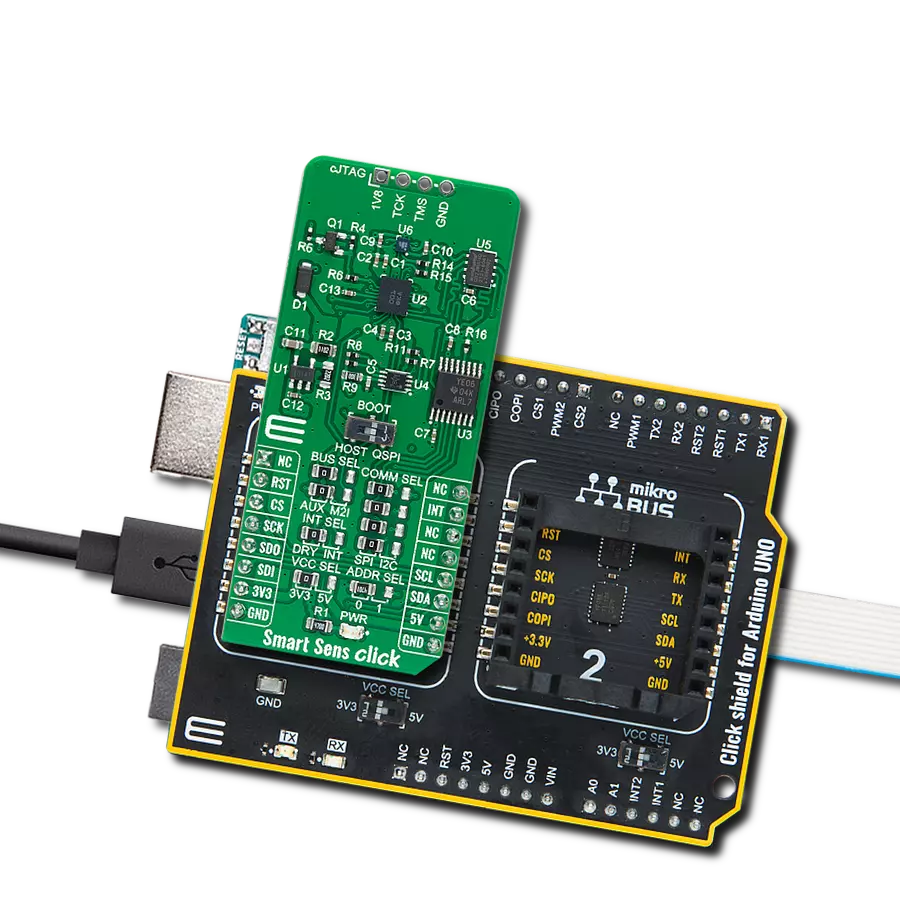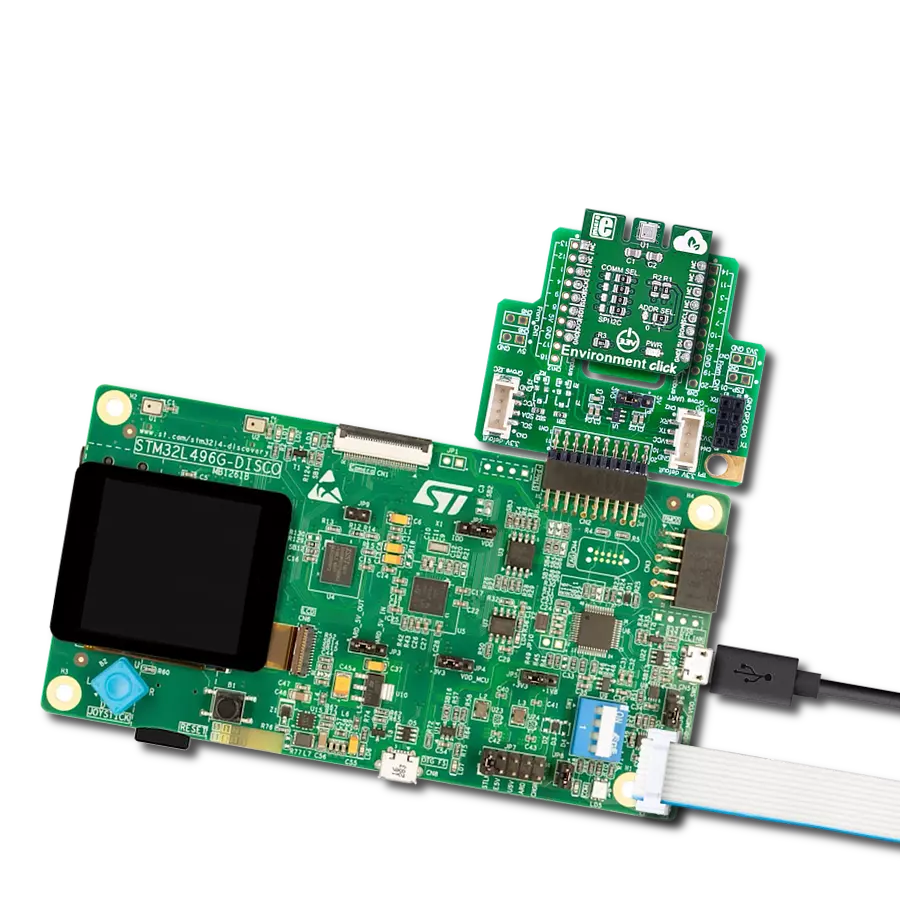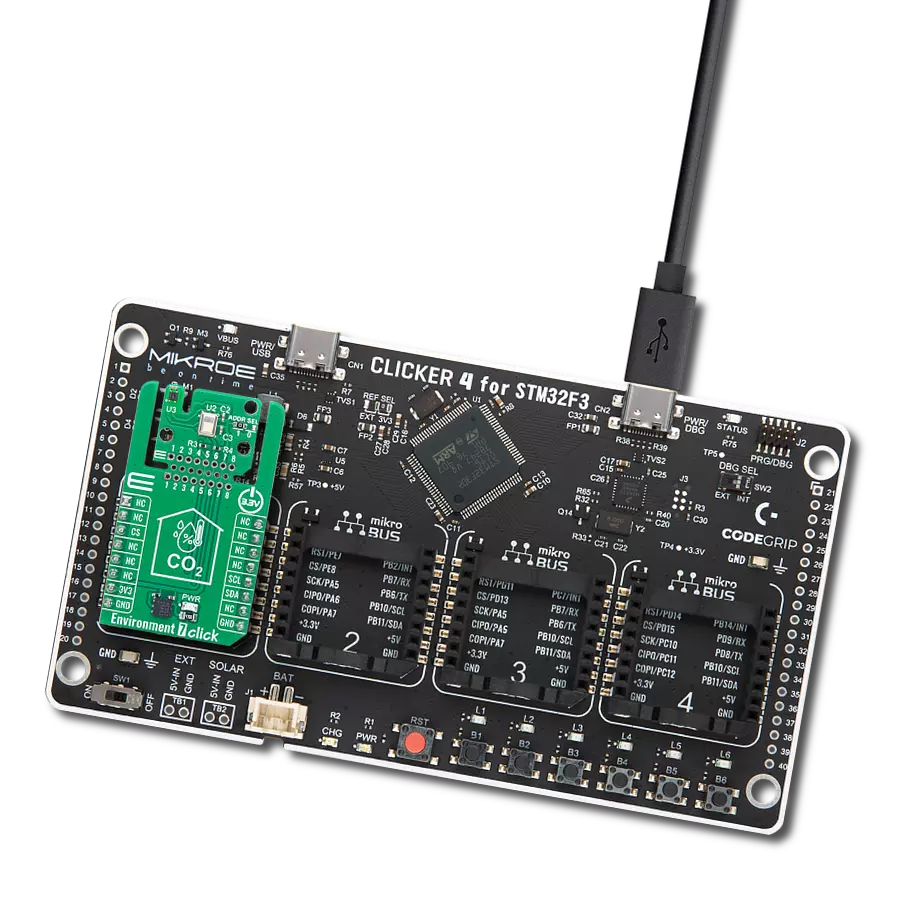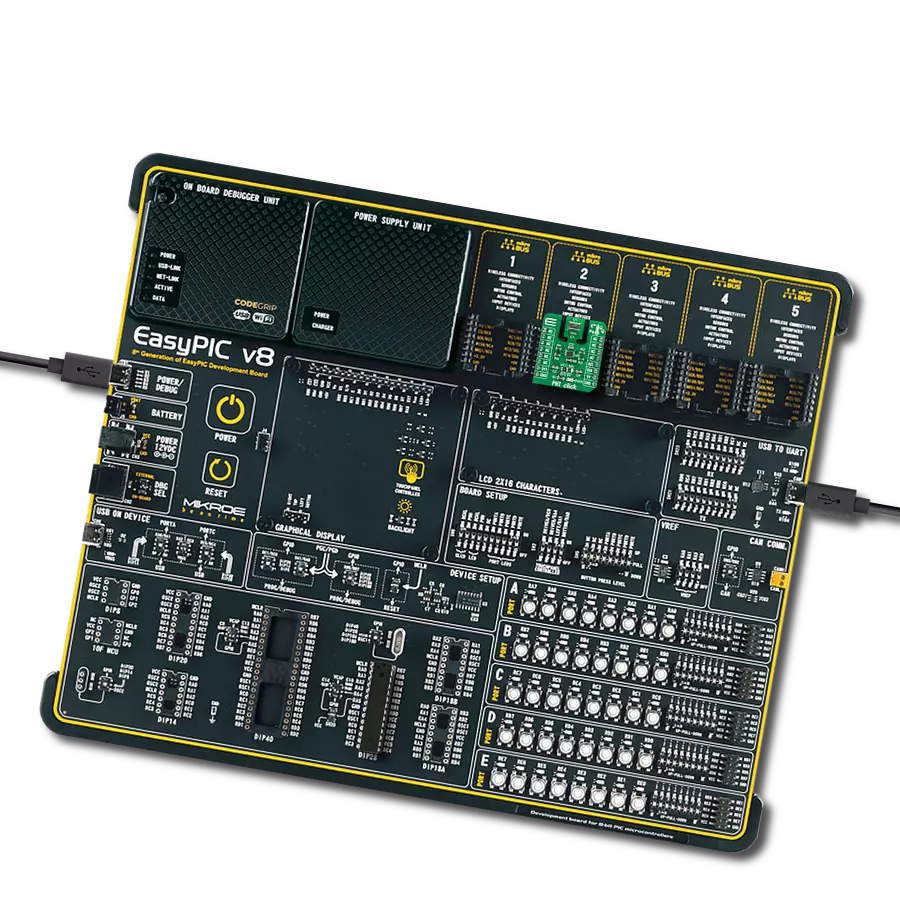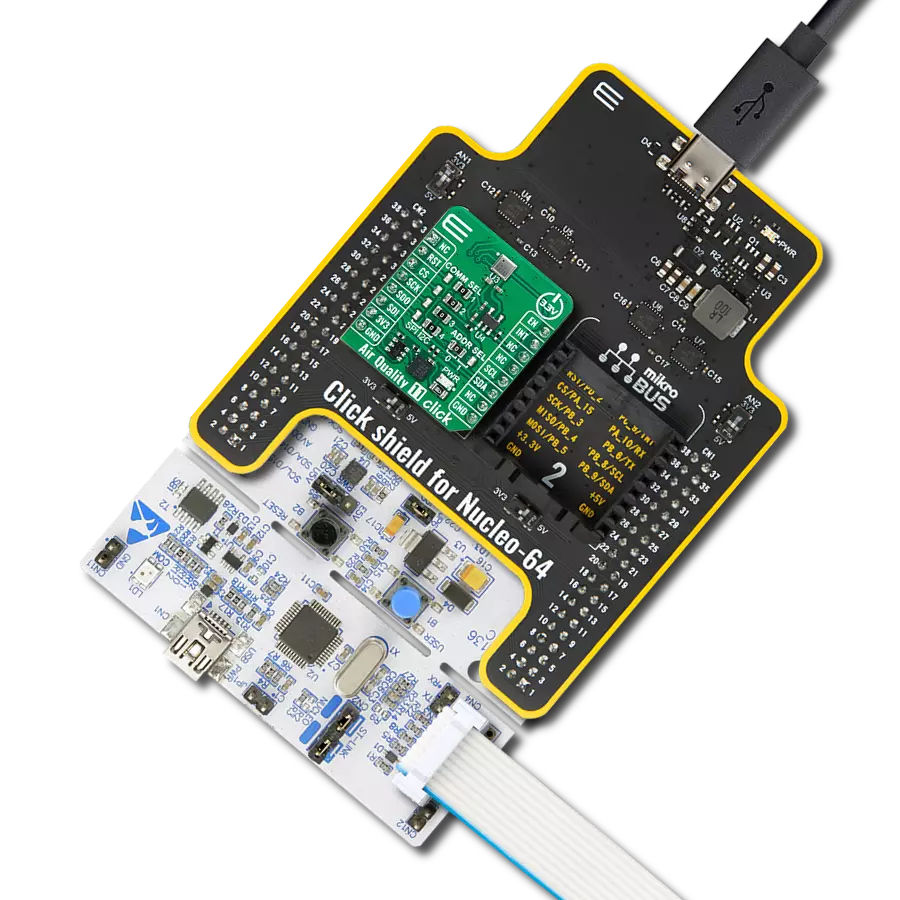Accurate water chemistry analysis solution compatible with conductivity probes of various conductance levels (from K 0.01 to K 10.2)
A
A
Hardware Overview
How does it work?
EZO Carrier Click - Conductivity is based on the EZO-EC™, an ISO 7888 compliant embedded conductivity circuit board from Atlas Scientific. This is a versatile and accurate solution for measuring conductivity, salinity, and Total Dissolved Solids (TDS) in various applications from chemical production to hydroponics. With a conductivity range of 0.07 to over 500,000 μS/cm, it can also accurately measure salinity up to 42 PSU (ppt), TDS as ppm, and specific gravity of seawater between 1.00 and 1.300. This advanced module offers the precision and functionality comparable to high-end bench-top conductivity meters, making it an ideal choice for embedding into projects that require reliable water chemistry measurements. Boasting an accuracy of +/- 2% and a quick EC reading time of 600ms, the EZO-EC™ supports probes ranging from K 0.01 to K 10.2 of any brand. It allows for both two-point and three-point
calibration, ensuring precise measurements. Additionally, it features temperature compensation for more accurate readings across various conditions. This circuit is a very sensitive device, and its sensitivity gives it accuracy. That’s why the EZO-EC™ needs to be isolated from the host MCU; therefore, this Click™ board comes with the Si8400AB, a bidirectional isolator from Skyworks. The isolator provides standard bidirectional and I2C communication with a clock frequency of up to 1.7MHz. So, to eliminate the electrical noise, besides the Si8400AB isolator, the power supply voltage is also isolated. For this purpose, this Click™ board is equipped with the ROE-0505S, a DC/DC converter from Recom. EZO Carrier Click - Conductivity can use a standard 2-wire UART interface to communicate with the host MCU with the default baud rate of 9600bps. While using the UART interface, you can use the library we provide
or a simple ASCII set of commands. You can also choose a standard 2-wire I2C interface over the COMM SEL jumpers. From calibration to timed readings, the Atlas Scientific EZO-EC™ circuit is a drop-in solution to a complex measurement. It features sleep mode, continuous operation, find function, export/import calibration, on-module status LED, and many more features detailed and described in the attached datasheet. This Click board™ can operate with either 3.3V or 5V logic voltage levels selected via the VCC SEL jumper. This way, both 3.3V and 5V capable MCUs can use the communication lines properly. Also, this Click board™ comes equipped with a library containing easy-to-use functions and an example code that can be used as a reference for further development.
Features overview
Development board
Nucleo-64 with STM32F410RB MCU offers a cost-effective and adaptable platform for developers to explore new ideas and prototype their designs. This board harnesses the versatility of the STM32 microcontroller, enabling users to select the optimal balance of performance and power consumption for their projects. It accommodates the STM32 microcontroller in the LQFP64 package and includes essential components such as a user LED, which doubles as an ARDUINO® signal, alongside user and reset push-buttons, and a 32.768kHz crystal oscillator for precise timing operations. Designed with expansion and flexibility in mind, the Nucleo-64 board features an ARDUINO® Uno V3 expansion connector and ST morpho extension pin
headers, granting complete access to the STM32's I/Os for comprehensive project integration. Power supply options are adaptable, supporting ST-LINK USB VBUS or external power sources, ensuring adaptability in various development environments. The board also has an on-board ST-LINK debugger/programmer with USB re-enumeration capability, simplifying the programming and debugging process. Moreover, the board is designed to simplify advanced development with its external SMPS for efficient Vcore logic supply, support for USB Device full speed or USB SNK/UFP full speed, and built-in cryptographic features, enhancing both the power efficiency and security of projects. Additional connectivity is
provided through dedicated connectors for external SMPS experimentation, a USB connector for the ST-LINK, and a MIPI® debug connector, expanding the possibilities for hardware interfacing and experimentation. Developers will find extensive support through comprehensive free software libraries and examples, courtesy of the STM32Cube MCU Package. This, combined with compatibility with a wide array of Integrated Development Environments (IDEs), including IAR Embedded Workbench®, MDK-ARM, and STM32CubeIDE, ensures a smooth and efficient development experience, allowing users to fully leverage the capabilities of the Nucleo-64 board in their projects.
Microcontroller Overview
MCU Card / MCU
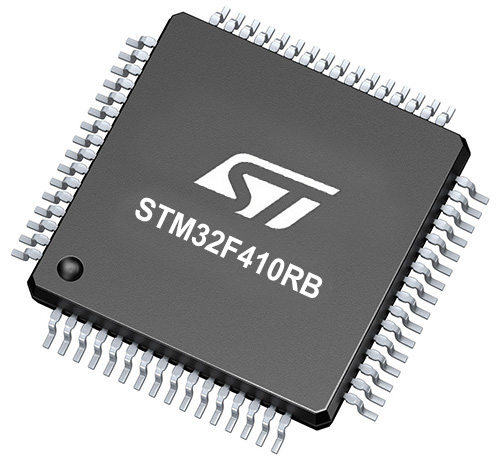
Architecture
ARM Cortex-M4
MCU Memory (KB)
128
Silicon Vendor
STMicroelectronics
Pin count
64
RAM (Bytes)
32768
You complete me!
Accessories
Click Shield for Nucleo-64 comes equipped with two proprietary mikroBUS™ sockets, allowing all the Click board™ devices to be interfaced with the STM32 Nucleo-64 board with no effort. This way, Mikroe allows its users to add any functionality from our ever-growing range of Click boards™, such as WiFi, GSM, GPS, Bluetooth, ZigBee, environmental sensors, LEDs, speech recognition, motor control, movement sensors, and many more. More than 1537 Click boards™, which can be stacked and integrated, are at your disposal. The STM32 Nucleo-64 boards are based on the microcontrollers in 64-pin packages, a 32-bit MCU with an ARM Cortex M4 processor operating at 84MHz, 512Kb Flash, and 96KB SRAM, divided into two regions where the top section represents the ST-Link/V2 debugger and programmer while the bottom section of the board is an actual development board. These boards are controlled and powered conveniently through a USB connection to program and efficiently debug the Nucleo-64 board out of the box, with an additional USB cable connected to the USB mini port on the board. Most of the STM32 microcontroller pins are brought to the IO pins on the left and right edge of the board, which are then connected to two existing mikroBUS™ sockets. This Click Shield also has several switches that perform functions such as selecting the logic levels of analog signals on mikroBUS™ sockets and selecting logic voltage levels of the mikroBUS™ sockets themselves. Besides, the user is offered the possibility of using any Click board™ with the help of existing bidirectional level-shifting voltage translators, regardless of whether the Click board™ operates at a 3.3V or 5V logic voltage level. Once you connect the STM32 Nucleo-64 board with our Click Shield for Nucleo-64, you can access hundreds of Click boards™, working with 3.3V or 5V logic voltage levels.
The Atlas Scientific conductivity probe, known as Probe K, stands out for its stable and precise readings across a wide range of conductivity. Free from fringe effects, it ensures accuracy within a range of 5 to 200,000μS/cm, with an impressive accuracy of ±2%. Responding swiftly, it achieves 90% accuracy in just 1 second, making it ideal for real-time monitoring applications. With a broad temperature range from 1 to 110°C, it can withstand diverse environmental conditions. Its robust construction allows for a maximum pressure of 3,447kPa (500PSI) and a maximum depth of 352 meters (1,157 feet). A 1-meter cable provides installation flexibility. Probe K boasts a long recalibration interval of approximately ten years, aligning with its equally impressive life expectancy. Probe K ensures reliable conductivity measurements for a decade and beyond with these features.
Used MCU Pins
mikroBUS™ mapper
Take a closer look
Click board™ Schematic

Step by step
Project assembly
Track your results in real time
Application Output
1. Application Output - In Debug mode, the 'Application Output' window enables real-time data monitoring, offering direct insight into execution results. Ensure proper data display by configuring the environment correctly using the provided tutorial.

2. UART Terminal - Use the UART Terminal to monitor data transmission via a USB to UART converter, allowing direct communication between the Click board™ and your development system. Configure the baud rate and other serial settings according to your project's requirements to ensure proper functionality. For step-by-step setup instructions, refer to the provided tutorial.

3. Plot Output - The Plot feature offers a powerful way to visualize real-time sensor data, enabling trend analysis, debugging, and comparison of multiple data points. To set it up correctly, follow the provided tutorial, which includes a step-by-step example of using the Plot feature to display Click board™ readings. To use the Plot feature in your code, use the function: plot(*insert_graph_name*, variable_name);. This is a general format, and it is up to the user to replace 'insert_graph_name' with the actual graph name and 'variable_name' with the parameter to be displayed.

Software Support
Library Description
This library contains API for EZO Carrier Click - Conductivity driver.
Key functions:
ezocarrierec_send_cmd- Send command functionezocarrierec_send_cmd_with_par- Send command function with parameterezocarrierec_send_cmd_check- Check the sent command
Open Source
Code example
The complete application code and a ready-to-use project are available through the NECTO Studio Package Manager for direct installation in the NECTO Studio. The application code can also be found on the MIKROE GitHub account.
/*!
* @file main.c
* @brief EZO Carrier EC Click Example.
*
* # Description
* This example demonstrates the use of EZO Carrier EC Click board by processing
* the incoming data and displaying them on the USB UART.
*
* The demo application is composed of two sections :
*
* ## Application Init
* Initializes the driver, performs the Click default factory reset, and single point calibration.
*
* ## Application Task
* Reads and processes all incoming conductivity data from the probe, and displays them on the USB UART in uS.
*
* ## Additional Function
* - static void ezocarrierec_clear_app_buf ( void )
* - static void ezocarrierec_log_app_buf ( void )
* - static err_t ezocarrierec_process ( ezocarrierec_t *ctx )
* - static err_t ezocarrierec_rsp_check ( ezocarrierec_t *ctx, uint8_t *rsp )
* - static void ezocarrierec_error_check ( err_t error_flag )
*
* @author Stefan Ilic
*
*/
#include "board.h"
#include "log.h"
#include "ezocarrierec.h"
// Application buffer size
#define APP_BUFFER_SIZE 200
#define PROCESS_BUFFER_SIZE 200
static ezocarrierec_t ezocarrierec;
static log_t logger;
static uint8_t app_buf[ APP_BUFFER_SIZE ] = { 0 };
static int32_t app_buf_len = 0;
static err_t error_flag;
/**
* @brief EZO Carrier EC clearing application buffer.
* @details This function clears memory of application buffer and reset its length.
* @note None.
*/
static void ezocarrierec_clear_app_buf ( void );
/**
* @brief EZO Carrier EC log application buffer.
* @details This function logs data from application buffer to USB UART.
* @note None.
*/
static void ezocarrierec_log_app_buf ( void );
/**
* @brief EZO Carrier EC data reading function.
* @details This function reads data from device and concatenates data to application buffer.
* @param[in] ctx : Click context object.
* See #ezocarrierec_t object definition for detailed explanation.
* @return @li @c 0 - Read some data.
* @li @c -1 - Nothing is read.
* See #err_t definition for detailed explanation.
* @note None.
*/
static err_t ezocarrierec_process ( ezocarrierec_t *ctx );
/**
* @brief Response check.
* @details This function checks for response and
* returns the status of response.
* @param[in] rsp Expected response.
* @return @li @c 0 - OK response.
* @li @c -1 - Error response.
* @li @c -2 - Timeout error.
* See #err_t definition for detailed explanation.
*/
static err_t ezocarrierec_rsp_check ( ezocarrierec_t *ctx, uint8_t *rsp );
/**
* @brief Check for errors.
* @details This function checks for different types of
* errors and logs them on UART or logs the response if no errors occured.
* @param[in] error_flag Error flag to check.
*/
static void ezocarrierec_error_check ( err_t error_flag );
void application_init ( void )
{
log_cfg_t log_cfg; /**< Logger config object. */
ezocarrierec_cfg_t ezocarrierec_cfg; /**< Click config object. */
/**
* Logger initialization.
* Default baud rate: 115200
* Default log level: LOG_LEVEL_DEBUG
* @note If USB_UART_RX and USB_UART_TX
* are defined as HAL_PIN_NC, you will
* need to define them manually for log to work.
* See @b LOG_MAP_USB_UART macro definition for detailed explanation.
*/
LOG_MAP_USB_UART( log_cfg );
log_init( &logger, &log_cfg );
log_info( &logger, " Application Init " );
// Click initialization.
ezocarrierec_cfg_setup( &ezocarrierec_cfg );
EZOCARRIEREC_MAP_MIKROBUS( ezocarrierec_cfg, MIKROBUS_1 );
if ( UART_ERROR == ezocarrierec_init( &ezocarrierec, &ezocarrierec_cfg ) )
{
log_error( &logger, " Communication init." );
for ( ; ; );
}
log_printf( &logger, "Device status \r\n" );
ezocarrierec_send_cmd( &ezocarrierec, EZOCARRIEREC_CMD_STATUS );
error_flag = ezocarrierec_rsp_check( &ezocarrierec, EZOCARRIEREC_RSP_OK );
ezocarrierec_error_check( error_flag );
log_printf( &logger, "Factory reset \r\n" );
ezocarrierec_send_cmd( &ezocarrierec, EZOCARRIEREC_CMD_FACTORY );
error_flag = ezocarrierec_rsp_check( &ezocarrierec, EZOCARRIEREC_RSP_READY );
ezocarrierec_error_check( error_flag );
#define PROBE_TYPE "1.0"
log_printf( &logger, "Seting Probe type \r\n" );
ezocarrierec_send_cmd_with_par( &ezocarrierec, EZOCARRIEREC_CMD_SET_PROBE_TYPE, PROBE_TYPE );
error_flag = ezocarrierec_rsp_check( &ezocarrierec, EZOCARRIEREC_RSP_OK );
ezocarrierec_error_check( error_flag );
log_printf( &logger, "Device info \r\n" );
ezocarrierec_send_cmd( &ezocarrierec, EZOCARRIEREC_CMD_DEV_INFO );
error_flag = ezocarrierec_rsp_check( &ezocarrierec, EZOCARRIEREC_RSP_OK );
ezocarrierec_error_check( error_flag );
#define DRY_CALIBRATION "dry"
log_printf( &logger, "Dry calibration \r\n" );
ezocarrierec_send_cmd_with_par( &ezocarrierec, EZOCARRIEREC_CMD_CAL, DRY_CALIBRATION );
error_flag = ezocarrierec_rsp_check( &ezocarrierec, EZOCARRIEREC_RSP_OK );
ezocarrierec_error_check( error_flag );
uint8_t n_cnt = 0;
uint8_t last_reading[ APP_BUFFER_SIZE ] = { 0 };
ezocarrierec_clear_app_buf( );
ezocarrierec_send_cmd( &ezocarrierec, EZOCARRIEREC_CMD_SINGLE_READ );
ezocarrierec_process ( &ezocarrierec );
strcpy( last_reading, app_buf );
log_printf( &logger, "Single point calibration \r\n" );
log_printf( &logger, "Waiting for stable readings \r\n" );
while ( n_cnt <= 5 )
{
if ( EZOCARRIEREC_OK == ezocarrierec_process ( &ezocarrierec ) )
{
if ( 0 == strstr( app_buf, last_reading ) )
{
n_cnt++;
}
else
{
strcpy( last_reading, app_buf );
n_cnt = 0;
}
}
log_printf( &logger, "- " );
Delay_ms ( 1000 );
ezocarrierec_clear_app_buf( );
}
#define CALIBRATION_VALUE "80"
log_printf( &logger, "Calibration \r\n" );
ezocarrierec_send_cmd_with_par( &ezocarrierec, EZOCARRIEREC_CMD_CAL, CALIBRATION_VALUE );
error_flag = ezocarrierec_rsp_check( &ezocarrierec, EZOCARRIEREC_RSP_OK );
ezocarrierec_error_check( error_flag );
#define DISABLE_CONT_READ "0"
log_printf( &logger, "Disable continuous reading mode \r\n" );
ezocarrierec_send_cmd_with_par( &ezocarrierec, EZOCARRIEREC_CMD_CONT_READ, DISABLE_CONT_READ );
error_flag = ezocarrierec_rsp_check( &ezocarrierec, EZOCARRIEREC_RSP_OK );
ezocarrierec_error_check( error_flag );
log_info( &logger, " Application Task " );
}
void application_task ( void )
{
log_printf( &logger, "Reading... \r\n" );
ezocarrierec_send_cmd( &ezocarrierec, EZOCARRIEREC_CMD_SINGLE_READ );
error_flag = ezocarrierec_rsp_check( &ezocarrierec, EZOCARRIEREC_RSP_OK );
ezocarrierec_error_check( error_flag );
Delay_ms ( 1000 );
Delay_ms ( 1000 );
Delay_ms ( 1000 );
Delay_ms ( 1000 );
Delay_ms ( 1000 );
}
int main ( void )
{
/* Do not remove this line or clock might not be set correctly. */
#ifdef PREINIT_SUPPORTED
preinit();
#endif
application_init( );
for ( ; ; )
{
application_task( );
}
return 0;
}
static void ezocarrierec_clear_app_buf ( void )
{
memset( app_buf, 0, app_buf_len );
app_buf_len = 0;
}
static void ezocarrierec_log_app_buf ( void )
{
for ( int32_t buf_cnt = 0; buf_cnt < app_buf_len; buf_cnt++ )
{
log_printf( &logger, "%c", app_buf[ buf_cnt ] );
}
}
static err_t ezocarrierec_process ( ezocarrierec_t *ctx )
{
uint8_t rx_buf[ PROCESS_BUFFER_SIZE ] = { 0 };
int32_t overflow_bytes = 0;
int32_t rx_cnt = 0;
int32_t rx_size = ezocarrierec_generic_read( ctx, rx_buf, PROCESS_BUFFER_SIZE );
if ( ( rx_size > 0 ) && ( rx_size <= APP_BUFFER_SIZE ) )
{
if ( ( app_buf_len + rx_size ) > APP_BUFFER_SIZE )
{
overflow_bytes = ( app_buf_len + rx_size ) - APP_BUFFER_SIZE;
app_buf_len = APP_BUFFER_SIZE - rx_size;
memmove ( app_buf, &app_buf[ overflow_bytes ], app_buf_len );
memset ( &app_buf[ app_buf_len ], 0, overflow_bytes );
}
for ( rx_cnt = 0; rx_cnt < rx_size; rx_cnt++ )
{
if ( rx_buf[ rx_cnt ] )
{
app_buf[ app_buf_len++ ] = rx_buf[ rx_cnt ];
}
}
return EZOCARRIEREC_OK;
}
return EZOCARRIEREC_ERROR;
}
static err_t ezocarrierec_rsp_check ( ezocarrierec_t *ctx, uint8_t *rsp )
{
uint32_t timeout_cnt = 0;
uint32_t timeout = 10000;
err_t error_flag = EZOCARRIEREC_OK;
ezocarrierec_clear_app_buf( );
while ( ( 0 == strstr( app_buf, rsp ) ) &&
( 0 == strstr( app_buf, EZOCARRIEREC_RSP_ERROR ) ) )
{
error_flag |= ezocarrierec_process( ctx );
if ( timeout_cnt++ > timeout )
{
ezocarrierec_clear_app_buf( );
return EZOCARRIEREC_ERROR_TIMEOUT;
}
Delay_ms ( 1 );
}
Delay_ms ( 100 );
error_flag |= ezocarrierec_process( ctx );
if ( strstr( app_buf, rsp ) )
{
return EZOCARRIEREC_OK;
}
else if ( strstr( app_buf, EZOCARRIEREC_RSP_ERROR ) )
{
return EZOCARRIEREC_ERROR;
}
else
{
return EZOCARRIEREC_ERROR;
}
}
static void ezocarrierec_error_check ( err_t error_flag )
{
switch ( error_flag )
{
case EZOCARRIEREC_OK:
{
ezocarrierec_log_app_buf( );
break;
}
case EZOCARRIEREC_ERROR:
{
log_error( &logger, " Error!" );
break;
}
case EZOCARRIEREC_ERROR_TIMEOUT:
{
log_error( &logger, " Timeout!" );
break;
}
default:
{
log_error( &logger, " Unknown!" );
break;
}
}
log_printf( &logger, "- - - - - - - - - - - - - - -\r\n" );
Delay_ms ( 500 );
}
// ------------------------------------------------------------------------ END
Additional Support
Resources
Category:Environmental




















